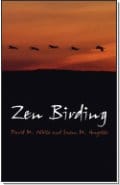Zen Birding
David M. White and Susan M. Guyette
O Books 2010; 194 pp., $16.95 (cloth)
A friend told me that if I went to a certain park across the bridge, I would see black-capped chickadees, and if I cupped some seeds in my hands while softly singing chick-a-dee-dee-dee, then they would perch on my fingers. These instructions sounded like a witch’s spell, complete with incantations; the promised outcome sounded like a Franciscan legend. All very enchanting. So my husband, Adán, and I bought ten pounds of birdseed and drove across the bridge.
The stuff of magic and miracles, however, was not forthcoming. We followed paths lined with spruce and birch, but it didn’t seem to matter which one we took; we saw nothing but crows, squirrels, and people walking dogs.
“Which way do you want to go now?” Adán asked.
“I don’t know.” The birdseed was heavy in my backpack.
He chose left. After walking a few feet, we came to a very narrow path between two clusters of saplings.
“Listen!” said Adán.
I couldn’t tell whether it was an insect chirping its wings or a birdcall. I just knew it didn’t sound like chick-a-dee-dee-dee as I was singing it. We slipped between the saplings, and found ourselves in a clearing. I scooped seeds into my palm and held them out to invisible birds.
Invisible until I saw one flitting from branch to branch.
“That’s it.” I whispered to Adán. It was tiny, with its distinctive black cap and bib, its white and buff belly, and its head that, though little, seemed a size too big. I sang for the chickadee, and it came—wrapped its feet around my finger and took a seed. Then it darted off and another chickadee touched down briefly. Both birds took one more seed each and that was all; they flew away like two hooded fairies.
“Birding can be a spiritual practice,” say Susan M. Guyette and her late husband, David M. White in their new book, Zen Birding. “Spirituality is about being aware of and participating in the connectedness between sentient beings.”
Through close observation, we come to understand on a gut level how little separates us and other creatures. Birds, like humans, look for mates, have families, feed themselves and their young, strive to stay out of danger. Birds, like humans, suffer. They get sick, grow old, and die. Realizing our essential sameness has the potential to make us more compassionate. We realize how our actions affect birds and their habitats, and we choose to be better stewards of the earth.
Like meditation, birding asks us to be still, to be quiet, to listen. And it allows our awareness to grow. We can become aware of ourselves—of ourselves watching—and we can develop a sense of gratitude for our physical body, for our senses.
“Consider your eyes,” says Zen master Thich Nhat Hanh in his book Fragrant Palm Leaves.
“How can we take something as wonderful as our eyes for granted? Yet we do. We don’t look deeply at these wonders. We ignore them, and, as a result, we lose them. It’s as though our eyes don’t exist. Only when we are struck blind do we realize how precious our eyes were, and then it’s too late. A blind person who regains her sight understands the preciousness of her eyes. She has the capacity to live happily right here on earth. The world of form and color is a miracle that offers blissful joys every day.”
Like a miracle—that’s how the chickadees’ appearance felt to me. But most long-term birders in Nova Scotia wouldn’t describe contact with Poecile atricapillus in that way. Chickadees are common here, so common that a wing-weary birder might call them “junk birds.” As Guyette and White point out, birders frequently become consumed by their lists. They count up the number of bird species they see in different ways. They have life lists, state lists, yearly, monthly, and daily lists. And, over time, what begins to count is not actually seeing a bird but having seen a bird, and common birds are not worth a second look.
To those who don’t inhabit the birding world, extreme birders, also known as “listers,” are perplexing, ridiculous even. Why aren’t they noticing the other aspects of nature’s beauty that are right in front of them—the curious pink mushrooms, the yellow leaf falling, the mackerel sky? Why are they traveling so far and trudging so doggedly through snow, swamps, and deserts just to get a neck cramp and a checkmark?
These are good questions, but they turn a blind eye to the fact that there are a lot of other people—people who have no interest in birds—who are listers or collectors of some kind and, moreover, that their ambitions are equally inane. They make a list of all the books they read, or buy a T-shirt from each Hard Rock Cafe they visit. They compete to get into the Guinness Book of World Records. They collect coins, brand names, electronics, hockey cards, lovers, or good grades. Indeed, maybe this impulse to achieve or collect is not something that affects many people, but rather most people. I know I’m no exception.
My listing mentality has long manifested in travel and food. In high school, just after my first trip to Europe, I got a blank world map and began filling in the countries I’d been to with pink and purple and green—conquering them with colored pencils. As for food, if there is a fruit I haven’t tasted, I’m hungry for it.
Trying to solidify the self through accomplishments or material goods is a natural impulse in our uncertain, impermanent world. But it doesn’t help. It doesn’t make life perfect; it doesn’t make us immortal; it doesn’t help us find wisdom. In fact, achieving and gaining can cause new kinds of suffering; our responsibilities and our worries can be compounded.
Much of Zen Birding is a warning to people who love birds: Don’t let that love turn into nothing more than a list, especially as an attempt to solidify the self. Knowing my own tendencies, I’m listening carefully to this warning, for after just six months of low-key birding I can feel the draw to novelty and checkmarks. There’s a world of interesting birds out there that I have never seen—and I would like to.
My husband searched the net for the world’s best singing bird and he stumbled upon a clip on YouTube from a BBC documentary showing Australia’s superb lyrebird. Mouse-colored and with long, strong dinosaurian talons, this is not a pretty creature, except maybe its tail, which fans out almost like a peacock’s. But the lyrebird has the ability to mimic the individual songs of other birds, as well as the chatter of flocks and the sounds of mammals, including humans and the things of their making: musical instruments, explosions, and machinery. In that video, I saw the lyrebird belt out the laughing song of a kookaburra, plus the sounds of a camera clicking, a car alarm howling, and a chainsaw grinding through wood.
Other avian wonders that I’ve recently seen in high definition and in books include the magnificent frigate bird, which flies over tropical waters, swooping in to steal fish from the beaks of other birds. Frigate birds have forked tails and are predominantly black, though their scapular feathers have a purple sheen and the males sport scarlet throats that inflate like balloons during the breeding season. Another curiosity is South America’s hoatzin, with its unfeathered blue face and red eyes. If a chick is in danger, it will fling itself from its nest, and then use little claws on its wing digits to haul itself back. Then there are the greater honeyguides of sub-Saharan Africa, who favor the delicacies of beehives: wax and eggs and larvae. Occupied hives, however, can be difficult for these birds to crack open on their own, so they sometimes chatter to get the attention of a honey-hungry human, baboon, or ratel and lead them to a hive. The common tribal tradition is to leave a sticky gift of comb for the honeyguide, because, it is said, otherwise—next time—the bird will lead them to danger.
The honeyguide, the hoatzin, the frigate bird, the lyrebird—there is nothing wrong with having a list with exotics like these on it, White and Guyette say, but take a good look at why you have this list and why it’s important to you. “Sincere introspection may reveal that aspirations for a big list are grounded in selfishness or egotism, both of which are barriers to true enjoyment of the undertaking.” Such reflection can make it possible to “possess the list,” instead of being possessed by it.
To borrow an expression from the Zen tradition, seasoned birders would do well to pick their binoculars up with “beginner’s mind,” that is, to be without preconceptions, to be eager and full of wonder. As Shunryu Suzuki Roshi said, “In the beginner’s mind there are many possibilities, in the expert’s mind there are few.” It is not possible for advanced birders to see exotic species every time they go birding, but they can see their region’s common birds with fresh eyes. As a new birder, I can—in a similar vein—cultivate more appreciation for what is. I can turn off the TV and fantasies, and concentrate on the birds that are possible to see right here in the present moment.
Some of them are pretty incredible. Take the cedar waxwing, which occasionally consumes too many fermented berries and falls down drunk when it tries to fly. A couple of days after I saw a cedar waxwing for the first time, I got on the phone with a friend and encouraged her to Google it.
“You saw that bird?” she asked when a photo appeared on her screen. She was as surprised as I’d been: This exotically beautiful creature—with a black mask and yellow belly that seems to glow pale and velveteen—is a common bird here? It has been flying over me all my life, without me noticing?
Then there are the ubiquitous crows. That day in the park, looking for chickadees, my husband and I just walked past them. In Zen Birding, however, White and Guyette remind readers that there is something beyond our preconceived notions of these birds too—something that shines a perfect iridescent black.
In 1420, Ikkyu, a celebrated Zen master, poet, and troublemaker, was meditating in a boat on Lake Biwa when he heard a crow cawing. That was the sound that woke him up, bringing him to satori, an experience of enlightenment. Ikkyu wrote:
For ten years my mind was cluttered with passion and anger.
Even at this moment, I still possess rage and violent emotions.
Yet in the instant that crow laughed, a rakan rose up out of ordinary dust.
In this morning’s sunshine, an illumined face sings.
Ikkyu and his world—even after enlightenment—were unchanged. But Ikkyu didn’t see it that way. With fresh eyes, magic and miracles are everyday.

